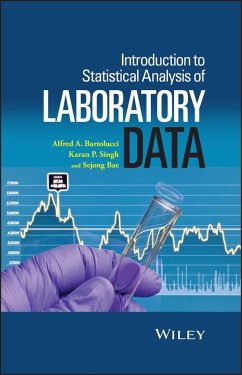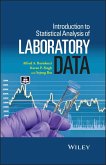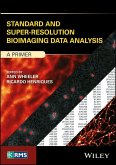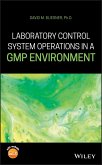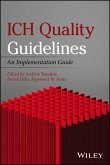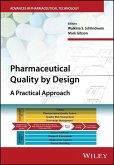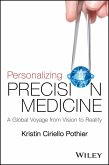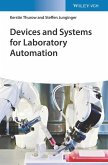Alfred Bartolucci, Karan P. Singh, Sejong Bae
Introduction to Statistical Analysis of Laboratory Data (eBook, ePUB)
111,99 €
111,99 €
inkl. MwSt.
Sofort per Download lieferbar

0 °P sammeln
111,99 €
Als Download kaufen

111,99 €
inkl. MwSt.
Sofort per Download lieferbar

0 °P sammeln
Jetzt verschenken
Alle Infos zum eBook verschenken
111,99 €
inkl. MwSt.
Sofort per Download lieferbar
Alle Infos zum eBook verschenken

0 °P sammeln
Alfred Bartolucci, Karan P. Singh, Sejong Bae
Introduction to Statistical Analysis of Laboratory Data (eBook, ePUB)
- Format: ePub
- Merkliste
- Auf die Merkliste
- Bewerten Bewerten
- Teilen
- Produkt teilen
- Produkterinnerung
- Produkterinnerung

Bitte loggen Sie sich zunächst in Ihr Kundenkonto ein oder registrieren Sie sich bei
bücher.de, um das eBook-Abo tolino select nutzen zu können.
Hier können Sie sich einloggen
Hier können Sie sich einloggen
Sie sind bereits eingeloggt. Klicken Sie auf 2. tolino select Abo, um fortzufahren.

Bitte loggen Sie sich zunächst in Ihr Kundenkonto ein oder registrieren Sie sich bei bücher.de, um das eBook-Abo tolino select nutzen zu können.
Introduction to Statistical Analysis of Laboratory Data presents a detailed discussion of important statistical concepts and methods of data presentation and analysis
Provides detailed discussions on statistical applications including a comprehensive package of statistical tools that are specific to the laboratory experiment process | Introduces terminology used in many applications such as the interpretation of assay design and validation as well as "fit for purpose" procedures including real world examples | Includes a rigorous review of statistical quality control procedures in…mehr
- Geräte: eReader
- ohne Kopierschutz
- eBook Hilfe
Andere Kunden interessierten sich auch für
![Introduction to Statistical Analysis of Laboratory Data (eBook, PDF) Introduction to Statistical Analysis of Laboratory Data (eBook, PDF)]() Alfred BartolucciIntroduction to Statistical Analysis of Laboratory Data (eBook, PDF)111,99 €
Alfred BartolucciIntroduction to Statistical Analysis of Laboratory Data (eBook, PDF)111,99 €![Standard and Super-Resolution Bioimaging Data Analysis (eBook, ePUB) Standard and Super-Resolution Bioimaging Data Analysis (eBook, ePUB)]() Standard and Super-Resolution Bioimaging Data Analysis (eBook, ePUB)80,99 €
Standard and Super-Resolution Bioimaging Data Analysis (eBook, ePUB)80,99 €![Laboratory Control System Operations in a GMP Environment (eBook, ePUB) Laboratory Control System Operations in a GMP Environment (eBook, ePUB)]() David M. BliesnerLaboratory Control System Operations in a GMP Environment (eBook, ePUB)126,99 €
David M. BliesnerLaboratory Control System Operations in a GMP Environment (eBook, ePUB)126,99 €![ICH Quality Guidelines (eBook, ePUB) ICH Quality Guidelines (eBook, ePUB)]() ICH Quality Guidelines (eBook, ePUB)311,99 €
ICH Quality Guidelines (eBook, ePUB)311,99 €![Pharmaceutical Quality by Design (eBook, ePUB) Pharmaceutical Quality by Design (eBook, ePUB)]() Pharmaceutical Quality by Design (eBook, ePUB)77,99 €
Pharmaceutical Quality by Design (eBook, ePUB)77,99 €![Personalizing Precision Medicine (eBook, ePUB) Personalizing Precision Medicine (eBook, ePUB)]() Kristin Ciriello PothierPersonalizing Precision Medicine (eBook, ePUB)21,99 €
Kristin Ciriello PothierPersonalizing Precision Medicine (eBook, ePUB)21,99 €![Devices and Systems for Laboratory Automation (eBook, ePUB) Devices and Systems for Laboratory Automation (eBook, ePUB)]() Kerstin ThurowDevices and Systems for Laboratory Automation (eBook, ePUB)115,99 €
Kerstin ThurowDevices and Systems for Laboratory Automation (eBook, ePUB)115,99 €-
-
-
Introduction to Statistical Analysis of Laboratory Data presents a detailed discussion of important statistical concepts and methods of data presentation and analysis
- Provides detailed discussions on statistical applications including a comprehensive package of statistical tools that are specific to the laboratory experiment process
- Introduces terminology used in many applications such as the interpretation of assay design and validation as well as "fit for purpose" procedures including real world examples
- Includes a rigorous review of statistical quality control procedures in laboratory methodologies and influences on capabilities
- Presents methodologies used in the areas such as method comparison procedures, limit and bias detection, outlier analysis and detecting sources of variation
- Analysis of robustness and ruggedness including multivariate influences on response are introduced to account for controllable/uncontrollable laboratory conditions
Dieser Download kann aus rechtlichen Gründen nur mit Rechnungsadresse in D ausgeliefert werden.
Produktdetails
- Produktdetails
- Verlag: John Wiley & Sons
- Erscheinungstermin: 2. November 2015
- Englisch
- ISBN-13: 9781119085003
- Artikelnr.: 44150240
- Verlag: John Wiley & Sons
- Erscheinungstermin: 2. November 2015
- Englisch
- ISBN-13: 9781119085003
- Artikelnr.: 44150240
- Herstellerkennzeichnung Die Herstellerinformationen sind derzeit nicht verfügbar.
Alfred A. Bartolucci is Professor Emeritus in the Department of Biostatistics, School of Public Health, University of Alabama at Birmingham. He has over 300 peer-reviewed publications (manuscripts and book chapters) in the areas of original statistical methodologic research and clinical and laboratory statistical applications. An endowed scholarship in Biostatistics at UAB was established in his honor.
Karan P. Singh is currently Professor of Medicine and serves as Director of the Biostatistics and Bioinformatics Shared Facility at the University of Alabama at Birmingham Comprehensive Cancer Center. He has authored or coauthored over 250 peer-reviewed articles, book chapters, and peer-reviewed congress or conference proceedings. He is a Fellow of the American Statistical association.
Sejong Bae is Professor of Medicine and serves as Co-Director of the Biostatistics and Bioinformatics Shared Facility; Deputy Director of the Coronary Artery Risk Development in Young Adults Coordination Center; and Director of Data, Information, and Statistics Core in the Division of Preventive Medicine. In 2009, he was elected to International Statistical Institute.
Karan P. Singh is currently Professor of Medicine and serves as Director of the Biostatistics and Bioinformatics Shared Facility at the University of Alabama at Birmingham Comprehensive Cancer Center. He has authored or coauthored over 250 peer-reviewed articles, book chapters, and peer-reviewed congress or conference proceedings. He is a Fellow of the American Statistical association.
Sejong Bae is Professor of Medicine and serves as Co-Director of the Biostatistics and Bioinformatics Shared Facility; Deputy Director of the Coronary Artery Risk Development in Young Adults Coordination Center; and Director of Data, Information, and Statistics Core in the Division of Preventive Medicine. In 2009, he was elected to International Statistical Institute.
Preface xi
Acknowledgments xv
1 DESCRIPTIVE STATISTICS 1
1.1 Measures of Central Tendency 1
1.2 Measures of Variation 4
1.3 Laboratory Example 7
1.4 Putting it All Together 8
1.5 Summary 10
References 10
2 DISTRIBUTIONS AND HYPOTHESIS TESTING IN FORMAL STATISTICAL LABORATORY PROCEDURES 11
2.1 Introduction 11
2.2 Confidence Intervals 19
2.2.1 Confidence Interval (CI) for the Population Mean - The t-Distribution 20
2.2.2 Confidence Interval for the Variance and Standard Deviation 21
2.3 Inferential Statistics - Hypothesis Testing 23
2.3.1 t-Test for Means 25
2.3.2 Test for Variation: Coefficient of Variation (CV) 28
2.3.3 Two-Sample Test of the Population Means 29
2.3.4 One-Way Analysis of Variance (ANOVA) 34
2.3.5 Nonparametric Tests for Skewed Data 40
References 41
3 METHOD VALIDATION 43
3.1 Introduction 43
3.2 Accuracy 45
3.2.1 Method 1 45
3.2.2 Method 2 56
3.3 Brief Introduction to Bioassay 59
3.3.1 Direct Assay 59
3.3.2 Indirect Assay 61
3.4 Sensitivity, Specificity (Selectivity) 69
3.5 Method Validation and Method Agreement - Bland-Altman 73
References 76
4 METHODOLOGIES IN OUTLIER ANALYSIS 79
4.1 Introduction 79
4.2 Some Outlier Determination Techniques 80
4.2.1 Grubb Statistic 82
4.2.2 Other Forms of the Grubb Statistic 84
4.2.3 Studentized Range Statistic 85
4.2.4 Sequential Test of Many Outliers 86
4.2.5 Mahalanobis Distance Measure 88
4.2.6 Dixon Q-Test for a Single Outlier 91
4.2.7 The Box Plot 94
4.2.8 Median Absolute Deviation 95
4.3 Combined Method Comparison Outlier Analysis 96
4.3.1 Further Outlier Considerations 96
4.3.2 Combined Method Comparison Outlier Analysis - Refined Method Comparisons Using Bland - Altman 98
4.4 Some Consequences of Outlier Removal 103
4.5 Considering Outlier Variance 104
4.5.1 The Cochran C test 104
4.5.2 Cochran G Test 107
References 110
5 STATISTICAL PROCESS CONTROL 113
5.1 Introduction 113
5.2 Control Charts 115
5.2.1 Means (X-bar) Control Charts 117
5.2.2 Range Control Charts 122
5.2.3 The S-Chart 124
5.2.4 The Median Chart 126
5.2.5 Mean (X-bar) and S-Charts Based on the Median Absolute Deviation (MAD) 128
5.3 Capability Analysis 131
5.4 Capability Analysis - An Alternative Consideration 137
References 139
6 LIMITS OF CALIBRATION 141
6.1 Calibration: Limit Strategies for Laboratory Assay Data 141
6.1.1 Definition - Calibration 141
6.2 Limit Strategies 142
6.2.1 Example - Estimation of LoB and LoD for Drug Assay 142
6.2.2 LoQ Results 144
6.2.3 A Comparison of Empirical and Statistical Approaches to the LoD and LoQ 145
6.2.4 Example - LoD/LoQ, GC - MS Approach 145
6.2.5 LoD/LoQ, GC - MS Approach 146
6.2.6 Explanation of the Difficulty of the Statistical Methodology for the LoD and LoQ 147
6.2.7 Another LoQ Method 151
6.3 Method Detection Limits (EPA) 151
6.3.1 Method Detection Limits 151
6.3.2 Example - Atrazine by Gas Chromatography (GC) 152
6.3.3 LoD and LoQ Summary 153
6.4 Data Near the Detection Limits 154
6.4.1 Biased Estimators 154
6.4.2 Computing Some Statistics with t
Acknowledgments xv
1 DESCRIPTIVE STATISTICS 1
1.1 Measures of Central Tendency 1
1.2 Measures of Variation 4
1.3 Laboratory Example 7
1.4 Putting it All Together 8
1.5 Summary 10
References 10
2 DISTRIBUTIONS AND HYPOTHESIS TESTING IN FORMAL STATISTICAL LABORATORY PROCEDURES 11
2.1 Introduction 11
2.2 Confidence Intervals 19
2.2.1 Confidence Interval (CI) for the Population Mean - The t-Distribution 20
2.2.2 Confidence Interval for the Variance and Standard Deviation 21
2.3 Inferential Statistics - Hypothesis Testing 23
2.3.1 t-Test for Means 25
2.3.2 Test for Variation: Coefficient of Variation (CV) 28
2.3.3 Two-Sample Test of the Population Means 29
2.3.4 One-Way Analysis of Variance (ANOVA) 34
2.3.5 Nonparametric Tests for Skewed Data 40
References 41
3 METHOD VALIDATION 43
3.1 Introduction 43
3.2 Accuracy 45
3.2.1 Method 1 45
3.2.2 Method 2 56
3.3 Brief Introduction to Bioassay 59
3.3.1 Direct Assay 59
3.3.2 Indirect Assay 61
3.4 Sensitivity, Specificity (Selectivity) 69
3.5 Method Validation and Method Agreement - Bland-Altman 73
References 76
4 METHODOLOGIES IN OUTLIER ANALYSIS 79
4.1 Introduction 79
4.2 Some Outlier Determination Techniques 80
4.2.1 Grubb Statistic 82
4.2.2 Other Forms of the Grubb Statistic 84
4.2.3 Studentized Range Statistic 85
4.2.4 Sequential Test of Many Outliers 86
4.2.5 Mahalanobis Distance Measure 88
4.2.6 Dixon Q-Test for a Single Outlier 91
4.2.7 The Box Plot 94
4.2.8 Median Absolute Deviation 95
4.3 Combined Method Comparison Outlier Analysis 96
4.3.1 Further Outlier Considerations 96
4.3.2 Combined Method Comparison Outlier Analysis - Refined Method Comparisons Using Bland - Altman 98
4.4 Some Consequences of Outlier Removal 103
4.5 Considering Outlier Variance 104
4.5.1 The Cochran C test 104
4.5.2 Cochran G Test 107
References 110
5 STATISTICAL PROCESS CONTROL 113
5.1 Introduction 113
5.2 Control Charts 115
5.2.1 Means (X-bar) Control Charts 117
5.2.2 Range Control Charts 122
5.2.3 The S-Chart 124
5.2.4 The Median Chart 126
5.2.5 Mean (X-bar) and S-Charts Based on the Median Absolute Deviation (MAD) 128
5.3 Capability Analysis 131
5.4 Capability Analysis - An Alternative Consideration 137
References 139
6 LIMITS OF CALIBRATION 141
6.1 Calibration: Limit Strategies for Laboratory Assay Data 141
6.1.1 Definition - Calibration 141
6.2 Limit Strategies 142
6.2.1 Example - Estimation of LoB and LoD for Drug Assay 142
6.2.2 LoQ Results 144
6.2.3 A Comparison of Empirical and Statistical Approaches to the LoD and LoQ 145
6.2.4 Example - LoD/LoQ, GC - MS Approach 145
6.2.5 LoD/LoQ, GC - MS Approach 146
6.2.6 Explanation of the Difficulty of the Statistical Methodology for the LoD and LoQ 147
6.2.7 Another LoQ Method 151
6.3 Method Detection Limits (EPA) 151
6.3.1 Method Detection Limits 151
6.3.2 Example - Atrazine by Gas Chromatography (GC) 152
6.3.3 LoD and LoQ Summary 153
6.4 Data Near the Detection Limits 154
6.4.1 Biased Estimators 154
6.4.2 Computing Some Statistics with t
Preface xi
Acknowledgments xv
1 DESCRIPTIVE STATISTICS 1
1.1 Measures of Central Tendency 1
1.2 Measures of Variation 4
1.3 Laboratory Example 7
1.4 Putting it All Together 8
1.5 Summary 10
References 10
2 DISTRIBUTIONS AND HYPOTHESIS TESTING IN FORMAL STATISTICAL LABORATORY PROCEDURES 11
2.1 Introduction 11
2.2 Confidence Intervals 19
2.2.1 Confidence Interval (CI) for the Population Mean - The t-Distribution 20
2.2.2 Confidence Interval for the Variance and Standard Deviation 21
2.3 Inferential Statistics - Hypothesis Testing 23
2.3.1 t-Test for Means 25
2.3.2 Test for Variation: Coefficient of Variation (CV) 28
2.3.3 Two-Sample Test of the Population Means 29
2.3.4 One-Way Analysis of Variance (ANOVA) 34
2.3.5 Nonparametric Tests for Skewed Data 40
References 41
3 METHOD VALIDATION 43
3.1 Introduction 43
3.2 Accuracy 45
3.2.1 Method 1 45
3.2.2 Method 2 56
3.3 Brief Introduction to Bioassay 59
3.3.1 Direct Assay 59
3.3.2 Indirect Assay 61
3.4 Sensitivity, Specificity (Selectivity) 69
3.5 Method Validation and Method Agreement - Bland-Altman 73
References 76
4 METHODOLOGIES IN OUTLIER ANALYSIS 79
4.1 Introduction 79
4.2 Some Outlier Determination Techniques 80
4.2.1 Grubb Statistic 82
4.2.2 Other Forms of the Grubb Statistic 84
4.2.3 Studentized Range Statistic 85
4.2.4 Sequential Test of Many Outliers 86
4.2.5 Mahalanobis Distance Measure 88
4.2.6 Dixon Q-Test for a Single Outlier 91
4.2.7 The Box Plot 94
4.2.8 Median Absolute Deviation 95
4.3 Combined Method Comparison Outlier Analysis 96
4.3.1 Further Outlier Considerations 96
4.3.2 Combined Method Comparison Outlier Analysis - Refined Method Comparisons Using Bland - Altman 98
4.4 Some Consequences of Outlier Removal 103
4.5 Considering Outlier Variance 104
4.5.1 The Cochran C test 104
4.5.2 Cochran G Test 107
References 110
5 STATISTICAL PROCESS CONTROL 113
5.1 Introduction 113
5.2 Control Charts 115
5.2.1 Means (X-bar) Control Charts 117
5.2.2 Range Control Charts 122
5.2.3 The S-Chart 124
5.2.4 The Median Chart 126
5.2.5 Mean (X-bar) and S-Charts Based on the Median Absolute Deviation (MAD) 128
5.3 Capability Analysis 131
5.4 Capability Analysis - An Alternative Consideration 137
References 139
6 LIMITS OF CALIBRATION 141
6.1 Calibration: Limit Strategies for Laboratory Assay Data 141
6.1.1 Definition - Calibration 141
6.2 Limit Strategies 142
6.2.1 Example - Estimation of LoB and LoD for Drug Assay 142
6.2.2 LoQ Results 144
6.2.3 A Comparison of Empirical and Statistical Approaches to the LoD and LoQ 145
6.2.4 Example - LoD/LoQ, GC - MS Approach 145
6.2.5 LoD/LoQ, GC - MS Approach 146
6.2.6 Explanation of the Difficulty of the Statistical Methodology for the LoD and LoQ 147
6.2.7 Another LoQ Method 151
6.3 Method Detection Limits (EPA) 151
6.3.1 Method Detection Limits 151
6.3.2 Example - Atrazine by Gas Chromatography (GC) 152
6.3.3 LoD and LoQ Summary 153
6.4 Data Near the Detection Limits 154
6.4.1 Biased Estimators 154
6.4.2 Computing Some Statistics with t
Acknowledgments xv
1 DESCRIPTIVE STATISTICS 1
1.1 Measures of Central Tendency 1
1.2 Measures of Variation 4
1.3 Laboratory Example 7
1.4 Putting it All Together 8
1.5 Summary 10
References 10
2 DISTRIBUTIONS AND HYPOTHESIS TESTING IN FORMAL STATISTICAL LABORATORY PROCEDURES 11
2.1 Introduction 11
2.2 Confidence Intervals 19
2.2.1 Confidence Interval (CI) for the Population Mean - The t-Distribution 20
2.2.2 Confidence Interval for the Variance and Standard Deviation 21
2.3 Inferential Statistics - Hypothesis Testing 23
2.3.1 t-Test for Means 25
2.3.2 Test for Variation: Coefficient of Variation (CV) 28
2.3.3 Two-Sample Test of the Population Means 29
2.3.4 One-Way Analysis of Variance (ANOVA) 34
2.3.5 Nonparametric Tests for Skewed Data 40
References 41
3 METHOD VALIDATION 43
3.1 Introduction 43
3.2 Accuracy 45
3.2.1 Method 1 45
3.2.2 Method 2 56
3.3 Brief Introduction to Bioassay 59
3.3.1 Direct Assay 59
3.3.2 Indirect Assay 61
3.4 Sensitivity, Specificity (Selectivity) 69
3.5 Method Validation and Method Agreement - Bland-Altman 73
References 76
4 METHODOLOGIES IN OUTLIER ANALYSIS 79
4.1 Introduction 79
4.2 Some Outlier Determination Techniques 80
4.2.1 Grubb Statistic 82
4.2.2 Other Forms of the Grubb Statistic 84
4.2.3 Studentized Range Statistic 85
4.2.4 Sequential Test of Many Outliers 86
4.2.5 Mahalanobis Distance Measure 88
4.2.6 Dixon Q-Test for a Single Outlier 91
4.2.7 The Box Plot 94
4.2.8 Median Absolute Deviation 95
4.3 Combined Method Comparison Outlier Analysis 96
4.3.1 Further Outlier Considerations 96
4.3.2 Combined Method Comparison Outlier Analysis - Refined Method Comparisons Using Bland - Altman 98
4.4 Some Consequences of Outlier Removal 103
4.5 Considering Outlier Variance 104
4.5.1 The Cochran C test 104
4.5.2 Cochran G Test 107
References 110
5 STATISTICAL PROCESS CONTROL 113
5.1 Introduction 113
5.2 Control Charts 115
5.2.1 Means (X-bar) Control Charts 117
5.2.2 Range Control Charts 122
5.2.3 The S-Chart 124
5.2.4 The Median Chart 126
5.2.5 Mean (X-bar) and S-Charts Based on the Median Absolute Deviation (MAD) 128
5.3 Capability Analysis 131
5.4 Capability Analysis - An Alternative Consideration 137
References 139
6 LIMITS OF CALIBRATION 141
6.1 Calibration: Limit Strategies for Laboratory Assay Data 141
6.1.1 Definition - Calibration 141
6.2 Limit Strategies 142
6.2.1 Example - Estimation of LoB and LoD for Drug Assay 142
6.2.2 LoQ Results 144
6.2.3 A Comparison of Empirical and Statistical Approaches to the LoD and LoQ 145
6.2.4 Example - LoD/LoQ, GC - MS Approach 145
6.2.5 LoD/LoQ, GC - MS Approach 146
6.2.6 Explanation of the Difficulty of the Statistical Methodology for the LoD and LoQ 147
6.2.7 Another LoQ Method 151
6.3 Method Detection Limits (EPA) 151
6.3.1 Method Detection Limits 151
6.3.2 Example - Atrazine by Gas Chromatography (GC) 152
6.3.3 LoD and LoQ Summary 153
6.4 Data Near the Detection Limits 154
6.4.1 Biased Estimators 154
6.4.2 Computing Some Statistics with t
